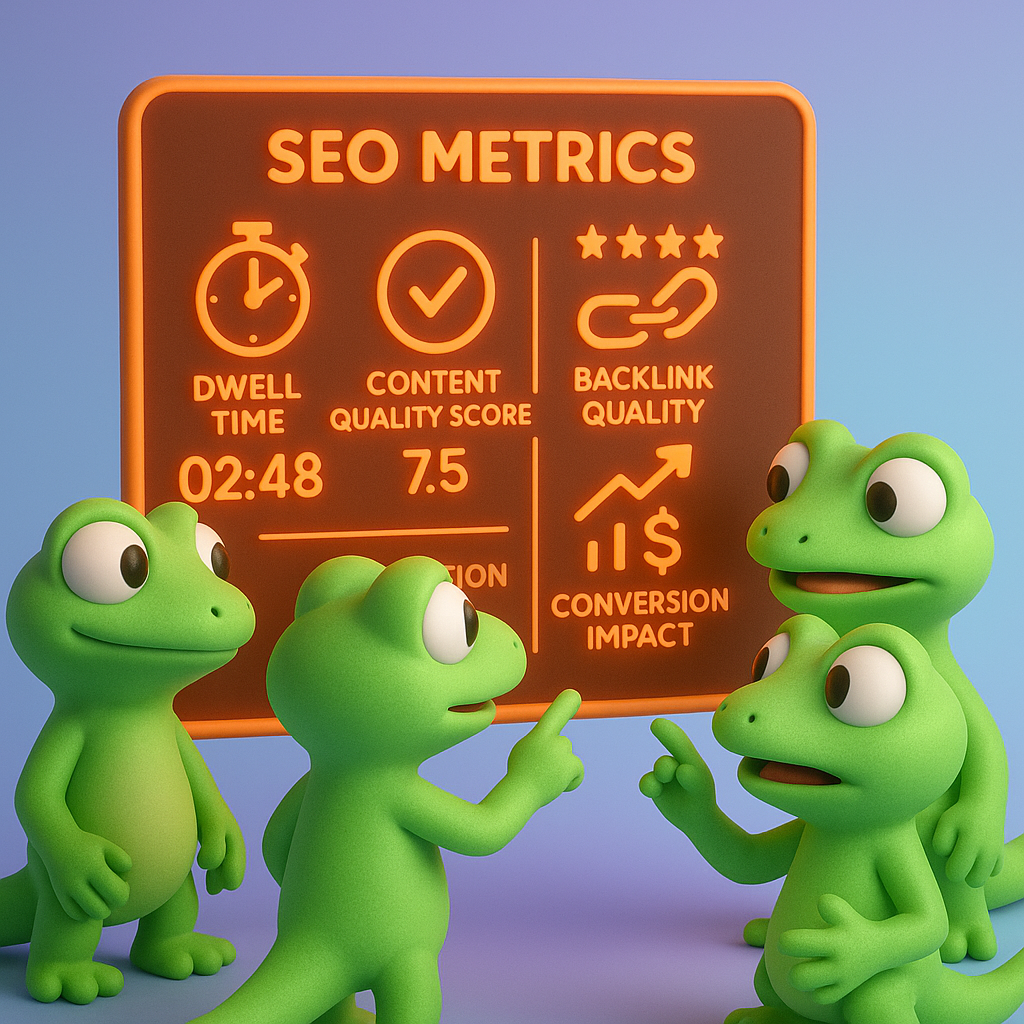Advanced SEO Metrics Beyond Traffic and Rankings for Marketing Leaders
Marketing leaders today need deeper SEO performance indicators than basic traffic and rankings to drive meaningful organic growth. As search algorithms evolve to prioritize experience and expertise, sophisticated measurement frameworks become essential for competitive advantage.
The Evolving SEO Metrics Landscape
Traditional SEO success metrics like keyword rankings and organic traffic tell only part of the story. Today’s marketing leaders require comprehensive measurement frameworks that assess multiple dimensions of organic search performance:

- User Engagement Signals
- Content Quality Indicators
- Backlink Quality Assessments
- Technical Performance Metrics
- Search Intent Alignment
- Conversion and Revenue Impact
User Engagement Metrics That Matter
Dwell Time & Pogo-Sticking
User engagement signals now outweigh traditional click-through rates. Track time spent on page and bounce-back behavior to gauge content relevance. According to research from CoreDNA, engagement signals like time on page, shares, and content saves have become critical ranking factors.
Think of dwell time as a digital “browse time” in a physical store—the longer someone lingers, the more likely they’re finding value. Conversely, pogo-sticking (quickly bouncing back to search results) signals a mismatch between user intent and your content.
AI Search Visibility
As zero-click searches rise, monitor your brand’s visibility in AI-generated search results like Google’s Featured Snippets or ChatGPT-style responses. This provides insight into your content’s authority beyond traditional rankings.
For example, a marketing automation company might track how often their definitions or explanations appear in AI responses to industry-specific queries, indicating content authority even without direct site visits.
Content Quality Indicators
Content Depth & Freshness Score
Sites that optimize for the “golden triangle” of content quality factors see 3x higher top-3 rankings:
- Link quality (9.8/10 importance)
- Content freshness (9.2/10 importance)
- Content depth (9.1/10 importance)
Using tools like ContentGecko can help automate content depth analysis and identify freshness improvement opportunities without requiring costly in-house teams.
Consider implementing a quarterly content refresh schedule for high-value pages, updating statistics, examples, and media while preserving the URL structure to maintain link equity.
Entity-Based SEO Metrics
Track semantic relevance indicators like:
- Brand mention frequency
- Related topic coverage
- E-E-A-T signals (Experience, Expertise, Authoritativeness, Trustworthiness)
These align with modern search intent understanding and can be optimized with free keyword grouping tools that cluster semantically related terms.
Entity optimization is particularly important for industries with high information sensitivity, like healthcare or finance, where search algorithms heavily weight expertise signals.
Backlink Quality Over Quantity
The SearchGPT algorithm now prioritizes link quality as the top ranking factor (9.8/10), making sophisticated backlink analysis essential. Focus measurement on:
- Domain authority trends
- Topical relevance of linking sites
- Referring domain growth rate
- Link velocity patterns
Enterprise marketing teams can leverage these insights using dedicated SEO reporting solutions that provide comprehensive backlink analysis.
Rather than pursuing 100 low-quality links, prioritize earning 10 highly relevant links from authoritative industry publications. One contextual link from a respected industry journal often delivers more ranking power than dozens of generic directory listings.
Technical SEO Health Scores
Core Web Vitals Optimization
Mobile-optimized sites enjoy a 23% ranking advantage over desktop-first competitors, according to research from DigiDop. Track these critical performance metrics:
- Largest Contentful Paint (LCP)
- First Input Delay (FID)
- Cumulative Layout Shift (CLS)
For ongoing monitoring, implement a website audit report system that tracks technical performance alongside content metrics.
Consider this analogy: Core Web Vitals are to your website what customer service metrics are to a physical store. Poor performance creates frustration and abandonment, regardless of how good your “merchandise” (content) might be.
Crawl Budget Utilization
Audit how search engines allocate crawl resources to your site:
- Crawl frequency metrics
- Pages crawled per visit
- Crawl-to-index ratio
These technical indicators help ensure your most valuable content gets discovered and indexed efficiently. Google Search Console provides these crawl stats, helping you identify potential indexing bottlenecks.
For large websites with thousands of pages, efficient crawl budget usage can mean the difference between new content being indexed in hours versus days or weeks.
Search Intent Alignment Metrics
Branded Search Volume Growth
Rising branded search volume signals increasing market awareness and trust. Track branded search trends alongside direct traffic patterns to measure brand equity development from SEO efforts.
For example, if your content marketing efforts are successful, you should see a correlation between publishing cadence and branded search volume growth over time, indicating increased market recognition.
Intent Match Scoring
Develop a proprietary scoring system to measure how well your content satisfies user intent compared to competitors. This can be tracked through:
- SERP feature capture rate
- Click-through rate by intent type
- Content gap analysis
Consider segmenting your analytics by search intent categories (informational, navigational, transactional, commercial investigation) to evaluate performance against each type separately.
Integrating Advanced SEO Metrics Into Your Reporting
Google Analytics 4 For Behavioral Insights
GA4 provides powerful capabilities for connecting SEO performance to user behavior. Create Google Analytics SEO reporting dashboards that track organic visitor journeys, engagement patterns, and conversion paths.
Set up custom segments for organic traffic to analyze how different content types perform in moving visitors through your conversion funnel, from awareness to consideration to decision.
Custom Dashboards For Executive Visibility
Build executive-friendly visualizations using Data Studio SEO templates that connect the dots between advanced SEO metrics and business outcomes. This helps secure continued investment in organic search initiatives.
Focus on translating technical metrics into business language: instead of reporting “improved Core Web Vitals,” frame it as “enhanced user experience leading to 15% higher conversion rates from mobile visitors.”
Keyword Tracking Evolution
Traditional rank tracking has evolved to include more sophisticated dimensions. Use unlimited keyword rank tracking tools that monitor:
- Mobile vs. desktop ranking disparities
- Local SERP variations
- Featured snippet capture rate
- People Also Ask visibility
This multidimensional tracking provides a more accurate picture of your true search visibility across different contexts and devices.
Measuring SEO ROI Beyond Traffic
To demonstrate SEO’s full business impact, marketing leaders need to connect organic performance to revenue outcomes. Implement an SEO ROI calculator to quantify:
- Customer acquisition cost via organic search
- Lifetime value of organic customers
- Cost avoidance compared to paid channels
- Organic revenue contribution
Case studies show organizations balancing technical metrics and content quality have achieved up to 45% traffic increases and significantly improved conversion rates, according to data from DigiDop.
For example, a B2B software company might calculate that their organic search channel delivers customers with a 20% higher retention rate than paid acquisition, justifying increased investment in SEO over PPC.
Internal Linking Strategy Effectiveness
Strategic internal linking improves crawlability and contextual relevance. A recent study revealed 76.6% of posts saw ranking improvements after implementing structured internal linking—without any content updates—as highlighted in research from SetupAd. Track:
- Internal link distribution
- Orphaned page reduction
- Click depth optimization
- PageRank flow efficiency
Consider using AI-powered tools like content writing bots that automatically suggest internal linking opportunities during content creation.
Internal linking is akin to creating signposts throughout your digital property—when strategically implemented, it guides both users and search engines to your most valuable content, improving both user experience and indexation efficiency.

TL;DR
Advanced SEO performance measurement requires looking beyond traffic and rankings to engagement signals, content quality metrics, technical health indicators, and business impact measures. By implementing sophisticated analytics frameworks, marketing leaders can gain deeper insights into organic search performance and make data-driven optimization decisions that drive sustainable growth. Use integrated tools and custom reporting to connect SEO efforts directly to business outcomes and demonstrate clear ROI. The most successful SEO strategies in 2025 will balance technical excellence, content depth, and user experience optimization.
